|
The Art of the Coffee Tin
by Bob Brooke
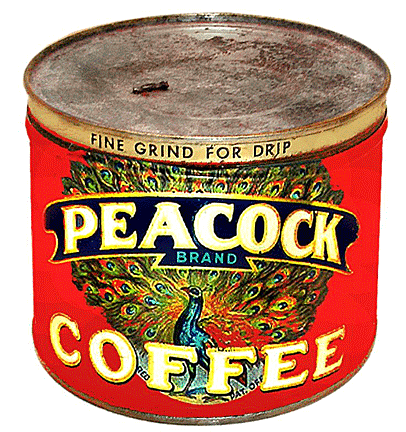 Soon
after establishing the first commercial canning factory in London,
England, in 1813, Bryan Dorkin and John Hall began packaging coffee in
tin-plated cans. Before this, ground or roasted coffee was mostly sold
in paper packaging or jars. At that time, most people bought green
coffee beans to roast and grind at home. Soon
after establishing the first commercial canning factory in London,
England, in 1813, Bryan Dorkin and John Hall began packaging coffee in
tin-plated cans. Before this, ground or roasted coffee was mostly sold
in paper packaging or jars. At that time, most people bought green
coffee beans to roast and grind at home.
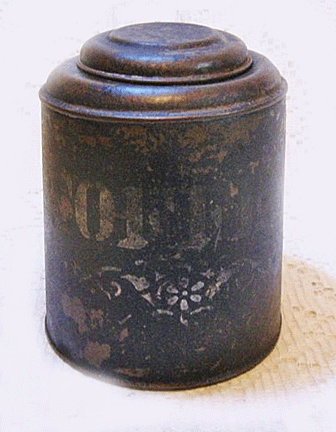 Over
the years, coffee containers were produced in many shapes and sizes;
they could be square, cylindrical, rectangular, or trapezoid-shaped and
ranged in size from one-ounce sample tins to large bins holding more
than fifty pounds of coffee. Coffee came in boxes and in pails with
metal handles in addition to tin; some containers were made of
cardboard, and others featured paper labels over the tin. Over
the years, coffee containers were produced in many shapes and sizes;
they could be square, cylindrical, rectangular, or trapezoid-shaped and
ranged in size from one-ounce sample tins to large bins holding more
than fifty pounds of coffee. Coffee came in boxes and in pails with
metal handles in addition to tin; some containers were made of
cardboard, and others featured paper labels over the tin.
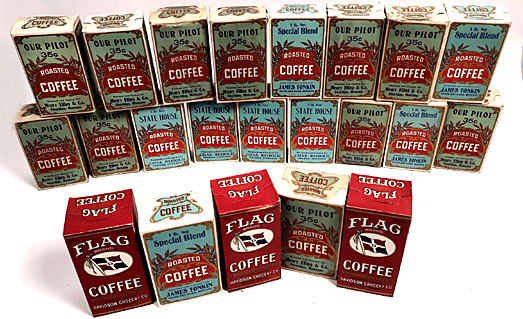
The lids also can be in various styles that evolved other the years. The
early tins had hinged lids or lids that could be pulled off. Later tins
were made with pry lids, slip lids, and lids that screwed off and on;
these were followed by lids that utilized keys for removal.
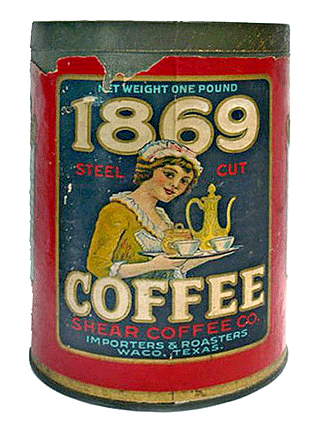 The
graphics and colors also evolved over time, from the plain early tins
that occasionally had paper or stenciled labels to tins that were
produced using a two-color tintype process. With the two-color process,
black was usually the dominant color which was used with green, red,
blue, or yellow. By 1914, the new process of chromolithography allowed
for the mass production of stunning multi-colored tins featuring
wonderful graphics. As coffee companies experimented with ways to
attract customers, they realized that they could sell more coffee by
producing reusable tin containers with beautiful graphics. Not only was
this very inexpensive advertising it also increased the likelihood that
the tin would be saved and reused for some other purpose. Tins were
often reused for storing any number of household items, such as nails,
buttons, or even some other food products The
graphics and colors also evolved over time, from the plain early tins
that occasionally had paper or stenciled labels to tins that were
produced using a two-color tintype process. With the two-color process,
black was usually the dominant color which was used with green, red,
blue, or yellow. By 1914, the new process of chromolithography allowed
for the mass production of stunning multi-colored tins featuring
wonderful graphics. As coffee companies experimented with ways to
attract customers, they realized that they could sell more coffee by
producing reusable tin containers with beautiful graphics. Not only was
this very inexpensive advertising it also increased the likelihood that
the tin would be saved and reused for some other purpose. Tins were
often reused for storing any number of household items, such as nails,
buttons, or even some other food products
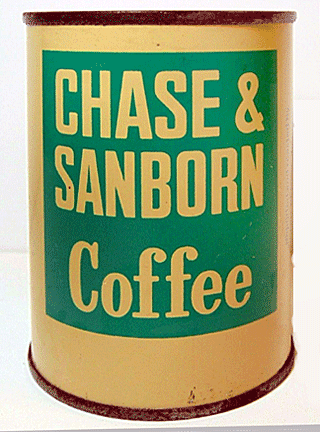 What
attracted both buyers and today’s collectors to coffee tins was the
eye-catching graphics and artwork on them. Today, the aged patina also
attracts collectors. What
attracted both buyers and today’s collectors to coffee tins was the
eye-catching graphics and artwork on them. Today, the aged patina also
attracts collectors.
Shortly after establishing the first commercial canning factory in
London, England, in 1813, Bryan Dorkin and John Hall began packaging
coffee in tin-plated cans. Before this, ground or roasted coffee was
mostly sold in paper packaging or jars. In 1878, Chase and Sandborn of
Boston, Massachusetts, was the first American company to package roasted
coffee in sealed tin cans.
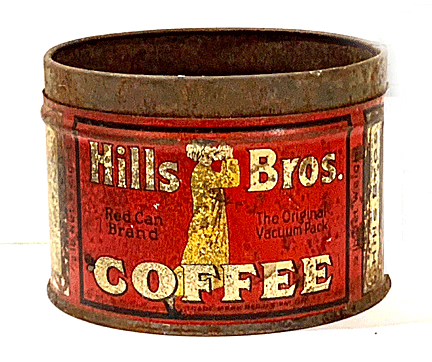 Hills
Bros. introduced their Red Can Brand signature red tin in 1914, after
inventing vacuum-packing. To enhance freshness, R.W. Hills of Hills
Bros. invented vacuum-packing in 1900. Hills’ vacuum tins kept the
coffee fresher for longer by removing air from the inside of the can
during the sealing process. Hills
Bros. introduced their Red Can Brand signature red tin in 1914, after
inventing vacuum-packing. To enhance freshness, R.W. Hills of Hills
Bros. invented vacuum-packing in 1900. Hills’ vacuum tins kept the
coffee fresher for longer by removing air from the inside of the can
during the sealing process.
In 1906, George Washington (not the U.S. president) created the first
mass-produced instant coffee packaged in tins. However, with the start
of World War I, tin became scarce, so coffee packers began using paper
and fiber containers until the end of the war. Coffee continued to be
packaged and sold in tin cans, later tin-plated steel cans, throughout
the 20th century.
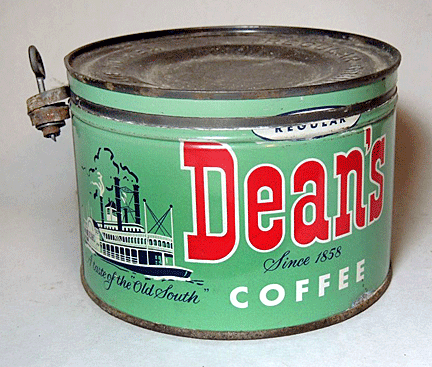 There
are several ways to date coffee tins. One is the graphics on the tins.
The artwork on the tins evolved over the years. The lids can also help
determine the age of the can since they changed over the years. Early
tin cans had hinged lids or removable lids. Later tins were made with
pry-off lids, slip lids, and twist-off lids. These cans were followed by
lids that utilized keys (can openers) for removal. There
are several ways to date coffee tins. One is the graphics on the tins.
The artwork on the tins evolved over the years. The lids can also help
determine the age of the can since they changed over the years. Early
tin cans had hinged lids or removable lids. Later tins were made with
pry-off lids, slip lids, and twist-off lids. These cans were followed by
lids that utilized keys (can openers) for removal.
Coffee can collectors—and there’s a lot of them out there—are drawn to
certain vintage coffee cans for various reasons. Some collectors choose
cans based on their graphics or colors. Others choose cans for
sentimental reasons—perhaps they remember their parents or grandparents
using that particular coffee brand.
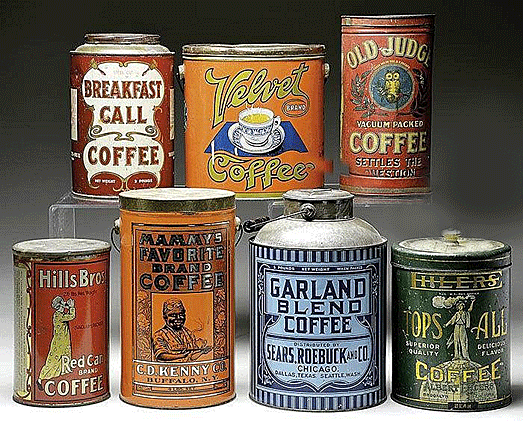
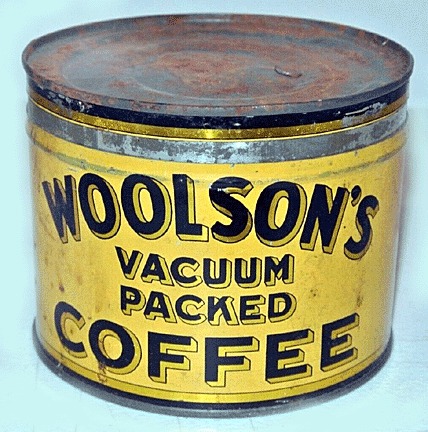 However,
certain types of coffee cans are more desired by collectors and are
typically higher priced. Sealed coffee cans still containing their
original coffee are highly desired by collectors, especially if they’re
earlier cans in mint condition. Regional coffee cans are also more
collectible since there were fewer produced, thereby making them
scarcer. However,
certain types of coffee cans are more desired by collectors and are
typically higher priced. Sealed coffee cans still containing their
original coffee are highly desired by collectors, especially if they’re
earlier cans in mint condition. Regional coffee cans are also more
collectible since there were fewer produced, thereby making them
scarcer.
As with most collectibles, age, condition, and rarity are vital factors
in determining the collectibility of coffee cans. Some early coffee cans
are copyright-dated, but that date only indicates the initial year of
issue, so it’s not the best indicator for age determination. However,
there are subtle clues that can help provide a timeframe. If the can’s
lettering includes “vacuum-packed” or some form of that wording, it was
made post-1900. If the words “patent pending” appear on the can, then it
was made after 1940.
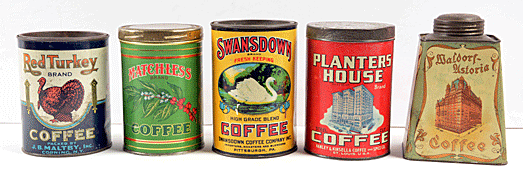
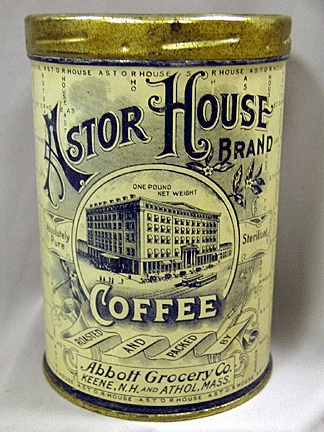 Some
manufacturers, like Hills Bros., made subtle changes in the graphics on
their cans throughout the years, which can narrow down a time line. Some
manufacturers, like Hills Bros., made subtle changes in the graphics on
their cans throughout the years, which can narrow down a time line.
Today coffee tins are highly collectible. In fact, they have become one
of the most sought-after types of antique advertising collectibles,
second only to tobacco tins. Although we call them tins, these
containers were not made entirely of tin but were initially made from
tin-plated sheets of iron. Later, manufacturers replaced iron with
steel. It is estimated that around two thousand different examples of
coffee tins were produced over the years, with countless millions sold.
However, despite the large number of tins manufactured, only very small
percentages have survived. Of those that did, many of the more desirable
ones have become almost impossible to find due to the many collectors
competing for them. This scarcity and popularity have caused prices to
soar dramatically in recent years.
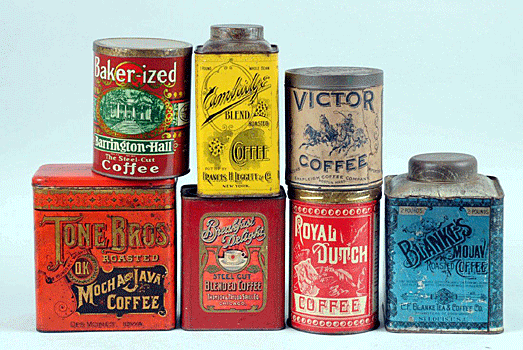
Fortunately, collectors can find coffee tins at antique shows and
auctions. Occasionally a great find can be uncovered at a flea market,
but this is becoming rare. Antiques and collectibles shows are still a
suitable venue for finding tins.
< Back to Collecting Archives
Next Article > |
